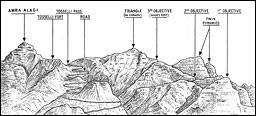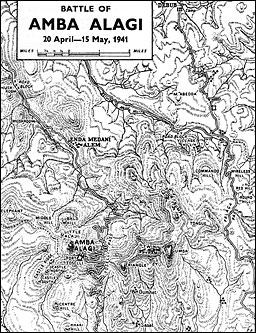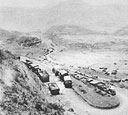
22
Amba Alagi--Surrender in Eritrea
The Dessie area was still being cleared by 1st S.A. Infantry Brigade Group, and the Engineers of 1st Field Company, S.A.E.C. were still removing road-blocks when the Natal Carbineers, with two batteries of 4th Field Brigade, S.A.A., two sections of 1st Field Company, and one platoon of No. 3 S.A. Armoured Car Company on 30 April 1941 moved out and headed northward on the main road for Asmara and the Red Sea port of Massawa, with Amba Alagi some 142 miles along the twisting route ahead of them. Now 2nd Reserve Motor Transport Company had to split two ways, to cope with the needs of elements of 1st S.A. Brigade Group in Dessie itself, and on the road to Amba Alagi. Coming 235 miles down from Asmara, such troops of Major-General A. G. O.M. Mayne's 5th Indian Division as could be spared from garrison duties in Eritrea were already putting strong pressure on the Amba Alagi redoubt, and the British Divisional Commander had fixed 4 May as the date for an assault entrusted to 29th Infantry Brigade.
The Viceroy, with the fall of Keren, had realized that collapse of Italian resistance in Eritrea could not long be delayed. Amba Alagi, hallowed by the memory of Pietro Toselli's heroic stand there in 1895, was one of the three redoubts selected for concentration of whatever forces could still be mustered to tie down British troops sorely needed by General Wavell in North Africa, as he was pressed to help in Iraq, to stem trouble in Syria and to face airborne invasion of Crete while trying to hold back the Afrika Korps at the Egyptian Frontier and retain his grip on beleaguered Tobruk.
On the heights of Amba Alagi and Mount Corarsi, in positions by nature even more formidable than Keren, the remnants of General Frusci's Eritrean Army had been joined by all that was left to the Duke of Aosta of his own central reserves. While they blocked the road from Addis Ababa to the Red Sea, General Gazzera was to continue resistance in Galla-Sidamo and General Nasi was to hold out to the last at Gondar, the northern approaches to which made both Keren and Amba Alagi look comparatively simple.
Only General Wavell's urgent need for clearing the road north of Addis Ababa had influenced General Piatt to turn Sudan Force towards Amba Alagi before tackling the more direct threat to the Sudan represented by the forces still at Gondar.1 To dislodge the Duke of Aosta would be an extremely difficult undertaking for any force approaching




